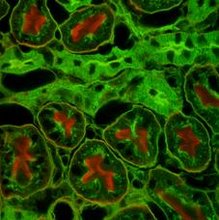
Aim: To study the technique of Ouchterlony double diffusion.
Principle:
Immunodiffusion in gels encompasses a variety of techniques, which are useful for the analysis of antigens and antibodies. An antigen reacts with a specific antibody to form an antigen-antibody complex, the composition of which depends on the nature, concentration and proportion of the initial reactants.
Immunodiffusion in gels are classified as single diffusion and double diffusion. In Ouchterlony double diffusion, both antigen and antibody are allowed to diffuse into the gel. This assay is frequently used for comparing different antigen preparations. In this test, different antigen preparations, each containing single antigenic species are allowed to diffuse from separate wells against the antiserum. Depending on the similarity between the antigens, different geometrical patterns are produced between the antigen and antiserum wells. The pattern of lines that from can be interpreted to determine whether the antigens are same or different as illustrated below.
Pattern of Identity: A
The antibodies in the antiserum react with both the antigens resulting in a smooth line of precipitate. The antibodies cannot distinguish between the two antigens i.e. the two antigens are immunologically identical.
Pattern of Partial Identity: B
In the pattern of partial identity, the antibodies in the antiserum react more with one of the antigens (the t diffuses from the left hand well in the figure) than the other. The ‘spur’ is thought to result from the determinants present in one antigen but lacking in the other antigen.
Pattern of Non-Identity: C
In the ‘pattern of non-identity’, none of the antibodies in the antiserum react with antigenic determinants that may be present in both the antigens i.e. the two antigens are immunologically unrelated as far as that antiserum is concerned.
Materials Provided:
Agarose, Assay buffer, Antiserum, Test antigens, Glass plate, Gel punch with syringe, Template
Requirement: Incubator (37 c), Conical flask, Measuring cylinder, Micropipettes, Moist chamber, Tips.
Reagents: Alcohol, Distilled water.
Procedure:
Prepare 25ml of 1.2% agarose (0.3 g/25ml) in 1x assay buffer by boiling to dissolve the agarose completely.
Cool the solution to 55-60 c and pour 4ml/plate on to 5 grease free glass plates placed on a horizontal surface. Allow the gel to set for 30 minutes.
Punch wells by keeping the glass plate on the template.
Fill the wells with to micro litter each of the antiserum and the corresponding antigens as shown bellow.
Keep the glass plate in a moist chamber overnight at 37 c.
After incubation, observe for opaque precipitin lines between the antigen and antisera wells.
Observation:
Observe for the presence of precipitin lines between antigen and antisera wells. Report the pattern of precipitin line observed in each case.
Principle:
Immunodiffusion in gels encompasses a variety of techniques, which are useful for the analysis of antigens and antibodies. An antigen reacts with a specific antibody to form an antigen-antibody complex, the composition of which depends on the nature, concentration and proportion of the initial reactants.
Immunodiffusion in gels are classified as single diffusion and double diffusion. In Ouchterlony double diffusion, both antigen and antibody are allowed to diffuse into the gel. This assay is frequently used for comparing different antigen preparations. In this test, different antigen preparations, each containing single antigenic species are allowed to diffuse from separate wells against the antiserum. Depending on the similarity between the antigens, different geometrical patterns are produced between the antigen and antiserum wells. The pattern of lines that from can be interpreted to determine whether the antigens are same or different as illustrated below.
Pattern of Identity: A
The antibodies in the antiserum react with both the antigens resulting in a smooth line of precipitate. The antibodies cannot distinguish between the two antigens i.e. the two antigens are immunologically identical.
Pattern of Partial Identity: B
In the pattern of partial identity, the antibodies in the antiserum react more with one of the antigens (the t diffuses from the left hand well in the figure) than the other. The ‘spur’ is thought to result from the determinants present in one antigen but lacking in the other antigen.
Pattern of Non-Identity: C
In the ‘pattern of non-identity’, none of the antibodies in the antiserum react with antigenic determinants that may be present in both the antigens i.e. the two antigens are immunologically unrelated as far as that antiserum is concerned.
Materials Provided:
Agarose, Assay buffer, Antiserum, Test antigens, Glass plate, Gel punch with syringe, Template
Requirement: Incubator (37 c), Conical flask, Measuring cylinder, Micropipettes, Moist chamber, Tips.
Reagents: Alcohol, Distilled water.
Procedure:
Prepare 25ml of 1.2% agarose (0.3 g/25ml) in 1x assay buffer by boiling to dissolve the agarose completely.
Cool the solution to 55-60 c and pour 4ml/plate on to 5 grease free glass plates placed on a horizontal surface. Allow the gel to set for 30 minutes.
Punch wells by keeping the glass plate on the template.
Fill the wells with to micro litter each of the antiserum and the corresponding antigens as shown bellow.
Keep the glass plate in a moist chamber overnight at 37 c.
After incubation, observe for opaque precipitin lines between the antigen and antisera wells.
Observation:
Observe for the presence of precipitin lines between antigen and antisera wells. Report the pattern of precipitin line observed in each case.
Interpretation:
If pattern A or pattern of identity is observed between the antigens and the antiserum, it indicates that the antigens are immunologically identical.
If pattern B or pattern of partial identity is observed, it indicates that the antigens are partially similar or cross-reactive.If pattern C or pattern of non-identity is observed, it indicates that there is no cross-reaction between the antigens. i.e. the two antigens are immunologically unrelated.
If pattern A or pattern of identity is observed between the antigens and the antiserum, it indicates that the antigens are immunologically identical.
If pattern B or pattern of partial identity is observed, it indicates that the antigens are partially similar or cross-reactive.If pattern C or pattern of non-identity is observed, it indicates that there is no cross-reaction between the antigens. i.e. the two antigens are immunologically unrelated.


No comments:
Post a Comment